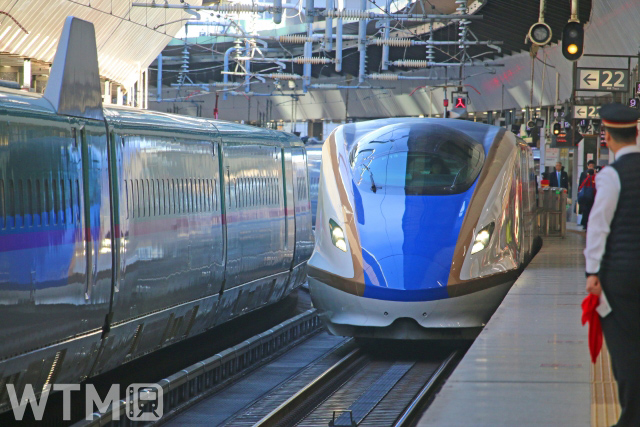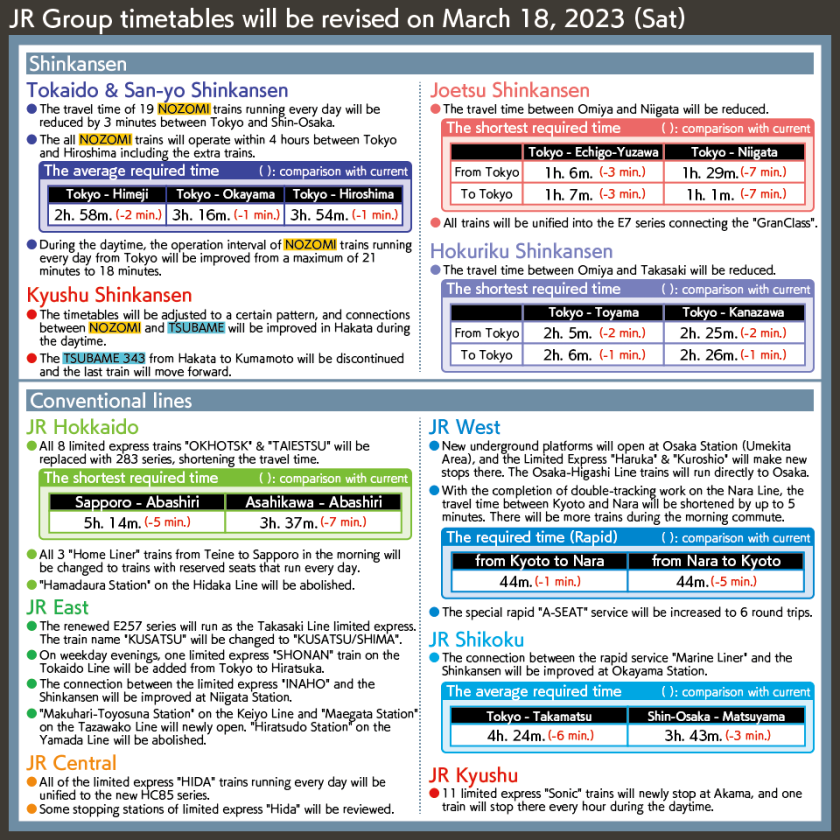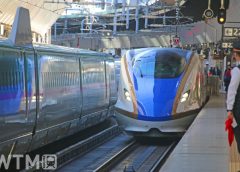The six JR Group passenger railway companies will revise their timetables on March 18, 2023 (Sat), speeding up and increasing the number of trains on the Shinkansen, opening new stations on conventional lines, and improving transportation through the progress of double-tracking.

All Joetsu Shinkansen will be E7 series
On the Tokaido Shinkansen, a total of 19 out of the regular “NOZOMI” trains that run every day will shorten the travel time between Tokyo and Shin-Osaka by 3 minutes, and the number of trains that will run in 2 hours 24 or 27 minutes will increase. Regular NOZOMI trains that run directly with the San-yo Shinkansen will also shorten the required time, and all NOZOMI trains, including extra ones, will run within four hours between Tokyo and Hiroshima. In addition, the departure interval of the regular NOZOMI at Tokyo Station will be leveled from a maximum of 21 to 18 minutes.
As for the extra NOZOMI trains, which operate on limited days or days of the week, one additional train will be added to the Tokaido/San-yo direct trains per hour during times of heavy use, making it possible to operate up to seven trains including regular NOZOMI. In addition, a extra NOZOMI round-trip service will be newly established on the Tokaido section in the early morning hours. Of these, the outbound “NOZOMI 491”, which operates mainly on Saturdays and Mondays, will depart from Shin-Yokohama Station (6:03, arriving Shin-Osaka at 8 :06). This is in line with the opening of the Sotetsu and Tokyu Shin-Yokohama Line on the same day as the revision, and is set in anticipation of increased demand from each line. Then, the new train “N700S” will be added to the Tokaido / San-yo Shinkansen, and the schedule of N700S NOZOMI trains that runs every day on the San-yo section will also be notified in advance.
All trains on the Joetsu Shinkansen will be unified into E7 series, and the maximum speed between Omiya and Niigata will be increased from 240km/h to 275km/h. As a result, the travel time between Tokyo and Niigata will be shortened by up to 7 minutes from the current time to 1 hour and 29 minutes (fastest). By reviewing the connection with the limited express “INAHO”, you will also be able to reach the Shonai area faster. In addition, the maximum speed of the Hokuriku Shinkansen, which shares the tracks between Omiya and Takasaki, will be increased, shortening the travel time between Tokyo and Hokuriku Area by up to 2 minutes.
On the Kyushu Shinkansen, the inbound “MIZUHO 600” departing Kagoshima-Chuo Station early in the morning running directly to San-yo Shinkansen will move up the operation time and reach Shin-Osaka Station about 30 minutes earlier. The operating times will be set in an easy-to-understand pattern centered around Hakata Station, and the transfer time between NOZOMI and “TSUBAME” at Hakata Station will also be shorten. During late-night hours, the operating schedule will be revised, and the last train from Hakata to Kumamoto will be moved forward by about 10 minutes (Refer to the chart below for details such as outlines of timetable revisions by JR companies).

“Umekita” underground platforms open at Osaka Station
On conventional lines, Makuhari-Toyosuna Station on the Keiyo Line (between Shin-Narashino and Kaihin Makuhari), and Maegata Station on the Tazawako Line (between Morioka and Ogama) will open respectively as JR East’s new stations. In the company’s area, E257 series renewal trains with improved comfort will be introduced to the limited express trains on the Takasaki Line. The number of Tokaido Line limited express “SHONAN” trains will be increased, and the operating section of some Joban and Chuo Line limited express trains will be extended. The major change in the timetable is on the JR / Tobu direct limited express, and while the number of regular trains will be halved from 4 round trips to 2 round trips per day. By adding extra trains during periods when it is expected to be crowded, such as Golden Week and the autumn leaves season, the suitable number of trains will be secured.
JR West will open a new underground platform on the Tokaido Freight Line in the “Umekita Area” that will be part of Osaka Station. All limited express “Haruka” and “Kuroshio” trains running on the line will stop at this station, improving access to Osaka Station by limited express not only from the Kansai Airport and Wakayama, but also Kyoto and Shiga. The Osaka-Higashi Line trains will also start running into the Umekita underground platforms, further enhancing the route network directly connected to Osaka Station. In addition, on the JR Kobe, JR Kyoto and Biwako Line, more special rapid trains that offer the paid seat service “A-SEAT” will be installed, increasing the chances of sitting during commuting in the morning and evening hours. Double-tracking work will complet on three sections totaling 14.0km on the Nara Line, shortening travel times and increasing the number of trains. Furthermore, there is no need to wait for oncoming trains, and the impact of delays is mitigated.
JR Hokkaido will unify all limited express trains “OKHOTSK” and “TAISETSU” on the Sekihoku Line into “Kiha 283 Series” trains, shortening the travel time between Sapporo and Abashiri. In addition, along with the opening of “Hokkaido Ballpark F Village” near Kitahiroshima Station, the schedule for the Chitose Line will be reviewed so that extra trains can be set. After the timetable revision, they will review the time on April 1, 2023 (Sat) due to the abolition of the section between Ishikari-Numata and Rumoi on the Rumoi Line. Also, on May 20 (Sat), they are planning to review the train system in line with the introduction of the new 737 series trains to the Muroran Line.
In addition, all regular trains of JR Central’s limited express “HIDA” will be unified to the new hybrid diesel train “HC85 series”, and some trains will stop at different stations from current. JR Shikoku will modify the operation schedules of the rapid “MARINE LINER” that connects with the San-yo Shinkansen at Okayama Station, and will work to improve access between Shikoku and the Kansai and Tokyo metropolitan areas. In addition, JR Kyushu will increase the number of limited express “SONIC” trains that stop at Akama Station on the Kagoshima Line, and in the Kumamoto area, in conjunction with the revision of the late-night Shinkansen timetable, the last train will move up.

 [Japan] Vasara Kimono Experience (Rental in Tokyo, Kamakura, Kyoto & Kurashiki) | Delight in high-quality service and trendy designs preferred by models (Ad by KKday)
[Japan] Vasara Kimono Experience (Rental in Tokyo, Kamakura, Kyoto & Kurashiki) | Delight in high-quality service and trendy designs preferred by models (Ad by KKday) [Tokyo Disney Resort] Seize the opportunity to experience legendary rides such as Pirates of the Caribbean & Splash Mountain (Ad by KKday)
[Tokyo Disney Resort] Seize the opportunity to experience legendary rides such as Pirates of the Caribbean & Splash Mountain (Ad by KKday)



